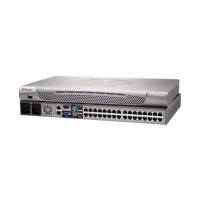
Do you have a question about the Raritan Dominion KX II and is the answer not in the manual?
| Model | Dominion KX II |
|---|---|
| Category | KVM Switch |
| Local Console Ports | 1 |
| Video Resolution | Up to 1920 x 1200 |
| Maximum Resolution | 1920 x 1200 |
| Network Interface | 10/100/1000 Mbps Ethernet |
| Audio Support | Yes |
| Form Factor | 1U Rackmount |
| On-Screen Display (OSD) | Yes |
| Power over Ethernet (PoE) | No |
| Ports | 16, 32 |
| Video Support | VGA, DVI, HDMI |
| USB Support | Yes |
| Security Features | SSL |
| Encryption | AES |
| Authentication | RADIUS, LDAP, Active Directory |
| Remote Access | Yes |
| Operating Temperature | 0°C to 40°C (32°F to 104°F) |
| Storage Temperature | -20°C to 60°C (-4°F to 140°F) |
| Humidity | 10% to 90% (non-condensing) |
| Number of Users Supported | Up to 64 concurrent users |
Provides a high-level overview of the Dominion KX II, its capabilities, and its architecture.
Lists all the items included in the KX II package for installation.
Details the hardware and software features of the Dominion KX II.
Provides instructions for physically installing the KX II into a server rack.
Details the default credentials required for initial access to the KX II.
A step-by-step guide for initial setup and configuration of the KX II.
Instructions on configuring firewall settings for network access.
Detailed steps for configuring the KX II device itself.
Procedures for accessing the KX II remotely via a web browser.
Explains the process of logging into the KX II interface.
Details on accessing the KX II directly at the rack.
Information on accessing the KX II remotely via network.
Explains the Port Access page for managing connections and targets.
Explains different mouse modes and settings for server interaction.
How to create, import, and manage custom keyboard macros.
Configures how KVM sessions are initiated.
Outlines requirements for using virtual media features.
Procedures for establishing and closing virtual media connections.
Instructions for managing power to connected equipment.
Explains the purpose and selection of USB profiles for server compatibility.
Guides on assigning USB profiles to KVM ports.
Information on creating and managing user groups for access control.
Process for adding, modifying, and managing user accounts.
Configuration of authentication methods (Local, LDAP, RADIUS).
Customizing network configuration, including IP and interface settings.
Enabling and configuring various device services like SSH, HTTP/HTTPS.
Managing port settings, including naming and associations.
Aggregating ports into groups for easier management.
Procedure for creating groups for dual video configurations.
Configuring login limitations, password rules, and encryption.
Enforcing complex password policies for enhanced security.
Configuring criteria to block users after failed login attempts.
Setting up IP-based access restrictions (ACLs).
Procedures for creating and installing SSL certificates.
Viewing and saving system event logs for accountability.
Accessing detailed information about the KX II and its CIMs.
Procedures for backing up and restoring device configuration.
Steps to upgrade the KX II unit and attached CIM firmware.
Safe and controlled procedure for restarting the KX II.
Displays the status of the network interface.
Tool to test network reachability of hosts or IP addresses.
Downloading diagnostic information or executing scripts for troubleshooting.
Methods for connecting to the KX II via SSH.
Understanding CLI navigation, syntax, and shortcuts.
Lists common commands for CLI navigation and configuration.
Describes at-the-rack access and administration via the local port.
Requirements for authenticating to use the local console.
How the Port Access page is displayed locally.
Steps to connect to a target server via the local console.
Using smart cards for server access via the local console.
Using hot keys for navigation and connecting to targets.
Details physical specifications of the KX II models.
Lists supported operating systems and browsers for KX II clients.
Provides specifications for various CIM models.
Introduces dual video port groups for extended desktop configurations.
Guidelines for setting up dual displays for mouse sync and orientation.
Step-by-step guide to configure dual video ports.
Step-by-step guide for connecting Paragon II to KX II.
How to retrieve user group information for authorization.
Steps to create new attributes for the rciusergroup class.
Important recommendations regarding Java cache and version.
Information on IPv6 support across different operating systems.
General notes and troubleshooting for virtual media.
Notes related to USB ports and profile management.
Notes on keyboard behavior and language settings.
Notes on video modes and resolution settings.
Information and troubleshooting for audio features.
Notes related to browser compatibility and issues.
Common questions and answers about the Dominion KX II.
Addresses questions about accessing the KX II remotely.
Covers questions related to virtual media support and types.
Discusses bandwidth usage and KVM-over-IP performance.
Covers questions related to Ethernet and IP networking for the KX II.
Covers questions related to IPv6 support and configuration.
Addresses questions about server compatibility and setup.
Covers questions related to connecting and managing blade servers.
Questions regarding security features like FIPS and encryption.
Questions about initial setup and required components.